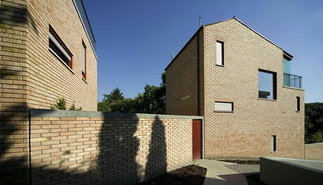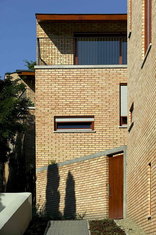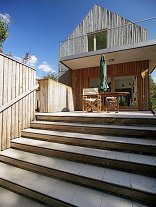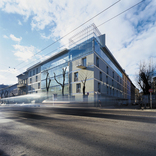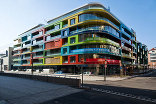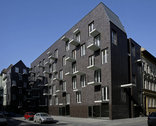Bauwerk
Housing complex
Tamás Tomay - Budapest (H) - 2007
24. Mai 2009 - Architekturarchiv Ungarn
Form-games
The houses are slightly different variations of one single basic form. The buildings and even the fence is made of brick; the roof and the eaves are of zinc sheets, the front doors and the gate of wood. The plain, strictly geometric brick-cubes are articulated by the seemingly random-placed window openings. They remain truly openings: not divided by transoms, but appear as simple rectangular figures, differing in size and orientation. The homogeneous brick surface is split by concrete elements in the same way. The sills of the windows and terraces are of prefabricated concrete. An other emphasized geometric form is the concrete ’beam’ running on the top of the fence – and turning down to the ground at the gate.
The terraces, running along the entire width of the buildings on the front facades, are further elements forming the building blocks by biting out of the geometric blocks of the houses. Whereas, the terrace on the side is only influencing the image of the facade – the openings under and above it open up wider to overlook on the garden. Special visual elements are on this spot the vertically folded wooden linings between the glass surfaces – as if they were curtains drawn aside. The metal bar-railing serves only its practical function – it has no specific role in the view or the mass of the house. A similar functional role is served by the underground tunnel, every inhabitant can reach the cellar and the garage under their houses through it.
Views
When we ascend on the slope of the plot it seems like rectangular building-blocks fall in behind each other, aligned but somehow a bit neglectful. But this is a studious negligence: the lower three have a similar siting, but the forth turns away. A similar override of the strict order and the rules of classic modernism is, that instead of the expected flat roof the architect uses the more practical, moderately pitched roof, with 13 and 30 degree slopes, turned so that the gables are on the side facades. This turning of the roof creates a more useful and efficient attic, and the pitched form visually breaks the orthogonal convention with its triangular form.
Brief, elegant and substantive solutions are used both in its materials and its forms on the row of apartment houses on the Csévi street. The little differences on the certain houses please the eye, after the successful siting the forming of the individual houses became free – between certain borders. But the architect, Tomay knows these borders quite well. Sarolta Entz
The houses are slightly different variations of one single basic form. The buildings and even the fence is made of brick; the roof and the eaves are of zinc sheets, the front doors and the gate of wood. The plain, strictly geometric brick-cubes are articulated by the seemingly random-placed window openings. They remain truly openings: not divided by transoms, but appear as simple rectangular figures, differing in size and orientation. The homogeneous brick surface is split by concrete elements in the same way. The sills of the windows and terraces are of prefabricated concrete. An other emphasized geometric form is the concrete ’beam’ running on the top of the fence – and turning down to the ground at the gate.
The terraces, running along the entire width of the buildings on the front facades, are further elements forming the building blocks by biting out of the geometric blocks of the houses. Whereas, the terrace on the side is only influencing the image of the facade – the openings under and above it open up wider to overlook on the garden. Special visual elements are on this spot the vertically folded wooden linings between the glass surfaces – as if they were curtains drawn aside. The metal bar-railing serves only its practical function – it has no specific role in the view or the mass of the house. A similar functional role is served by the underground tunnel, every inhabitant can reach the cellar and the garage under their houses through it.
Views
When we ascend on the slope of the plot it seems like rectangular building-blocks fall in behind each other, aligned but somehow a bit neglectful. But this is a studious negligence: the lower three have a similar siting, but the forth turns away. A similar override of the strict order and the rules of classic modernism is, that instead of the expected flat roof the architect uses the more practical, moderately pitched roof, with 13 and 30 degree slopes, turned so that the gables are on the side facades. This turning of the roof creates a more useful and efficient attic, and the pitched form visually breaks the orthogonal convention with its triangular form.
Brief, elegant and substantive solutions are used both in its materials and its forms on the row of apartment houses on the Csévi street. The little differences on the certain houses please the eye, after the successful siting the forming of the individual houses became free – between certain borders. But the architect, Tomay knows these borders quite well. Sarolta Entz
Für den Beitrag verantwortlich: Architekturarchiv Ungarn
Ansprechpartner:in für diese Seite: nextroom
